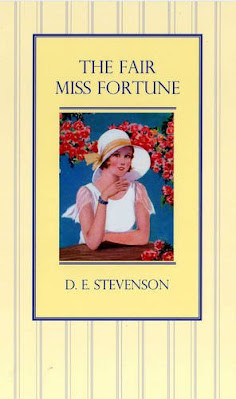Time really does fly, doesn't it? Our Molly Clavering and Ruby Ferguson titles are available and the reaction has been lovely, it's already almost July, it's year 30 or so of COVID, and we might as well start looking forward to 2022 and the new titles we have set for January.
This announcement will necessarily be a bit shorter and sweeter than most, since there aren't too many ways I can be coy about announcing eleven more titles by a much-beloved author who already has eight other titles on our backlist.
Hmmm, who could that be?!?!
Most of you can handily guess that this author is none other than the divine D. E. STEVENSON, and I'm overjoyed that, having thought at one time that we would be unable to release any more of her books, things have worked out so that we can now move forward with eleven more.
We're also making an unprecedented move with some of these. Of the eleven
books, six are currently completely out of print and we'll be releasing
those in both paperback and e-book editions, as per our norm. But the
other five, fan favorites all, are actually already available in e-book
format only from "another publisher", and we will be releasing Furrowed
Middlebrow paperback editions of those only. Ordinarily, we only consider
titles that are out of print in all formats, so that we can do our own
editions of both. (People are sometimes confused by this, urging us to
reprint books that are in fact already in print in e-book editions.)
However, if there were ever an author to make an exception for, it is
surely D. E. Stevenson!
Without further ado then, but with some of their original or previous reprint covers (some perhaps to be adapted for our covers???), and with the details of what formats we'll be publishing after each title, I give you, in chronological order, our eleven new titles:
1) The Fair Miss Fortune (about 1938), e-book and paperback
Written in the late 1930s around the time of Miss Buncle Married and Miss Bun the Baker's Daughter, The Fair Miss Fortune was originally rejected by her publisher. It was finally brought to print only a few years back by the wonderful Shirley Neilson at Greyladies Books. It's DES in her most playful mode, writing of the chaos caused by two sisters in a small village, and we're very excited to make it more widely available.
2) Green Money (1939), e-book and paperback
From just about the same period, and likewise DES in playful mode, this
is the tale of young George Ferrier, who is swept into a series of
rollicking adventures when he agrees to act as trustee for a wealthy man's
overprotected daughter.
3) The English Air (1940), paperback only
A fan favorite set during the final days of peace and the early days of
World War II, about the son of a Nazi official sent to stay with his
English cousins in order to assess English morale, with unexpected and
entertaining results.
4) Kate Hardy (1947), e-book and paperback
A successful novelist retreats to the village of Old Quinings to write,
but finds herself taken for a witch, becomes the target of a poison pen
campaign, and fields rumors that her house is haunted. A delightful
glimpse of English village life in the years immediately after WWII.
5) Young Mrs Savage (1948), e-book and paperback
Likewise set in the time of postwar rationing and austerity, this one has become a favorite of mine, the story of widowed Dinah, raising four young children on her own, who is sent on holiday to Scotland where she and her brood find adventure, misunderstandings, and the tentative beginnings of a new lease on life.
6) Five Windows (1953), paperback only
DES in somewhat more contemplative and nostalgic mode, as she traces the
early life of David Kirke via the five windows through which he has looked
out on the world.
7) Charlotte Fairlie (1954), e-book and paperback
Previously published as Blow the Wind Southerly and
The Enchanted Isle. Charlotte, headmistress of a prestigious girls'
school, finds her day-to-day challenges exacerbated by a desperately
homesick Scottish student and a trip to the beautiful isle of Targ.
8) The Tall Stranger (1957), paperback only
Barbie France, a successful young decorator, comes home to the Cotswolds following a breakdown, but that's just the beginning, and of course a trip to Scotland is in the offing. I first read this one just a couple of months ago and fell completely in love with it.
9) Anna and Her Daughters (1958), paperback only
The tale of Anna Harcourt and her three daughters, whose world is turned
upside down by their father's death and their mother's decision to move
them from London to her home town in Scotland. One of DES's more poignant,
wise tales of human nature and healing.
10) The Musgraves (1960), e-book and paperback
Following the death of her beloved husband, Esther believes she will never be happy again. But soon, her "natural buoyancy" and the problems and adventures of her three daughters bring her pleasure and purpose anew. A really lovely and addictive tale of family and village life.
11) The Blue Sapphire (1963), paperback only
Recently read and raved about here. Another recent discovery for me, and another of DES's best.
And that's that! More details of course to follow. We have lots of work to do before they're ready to release, but what a lot of fun it's going to be. Hope you're as pleased about these new titles as I am!



























